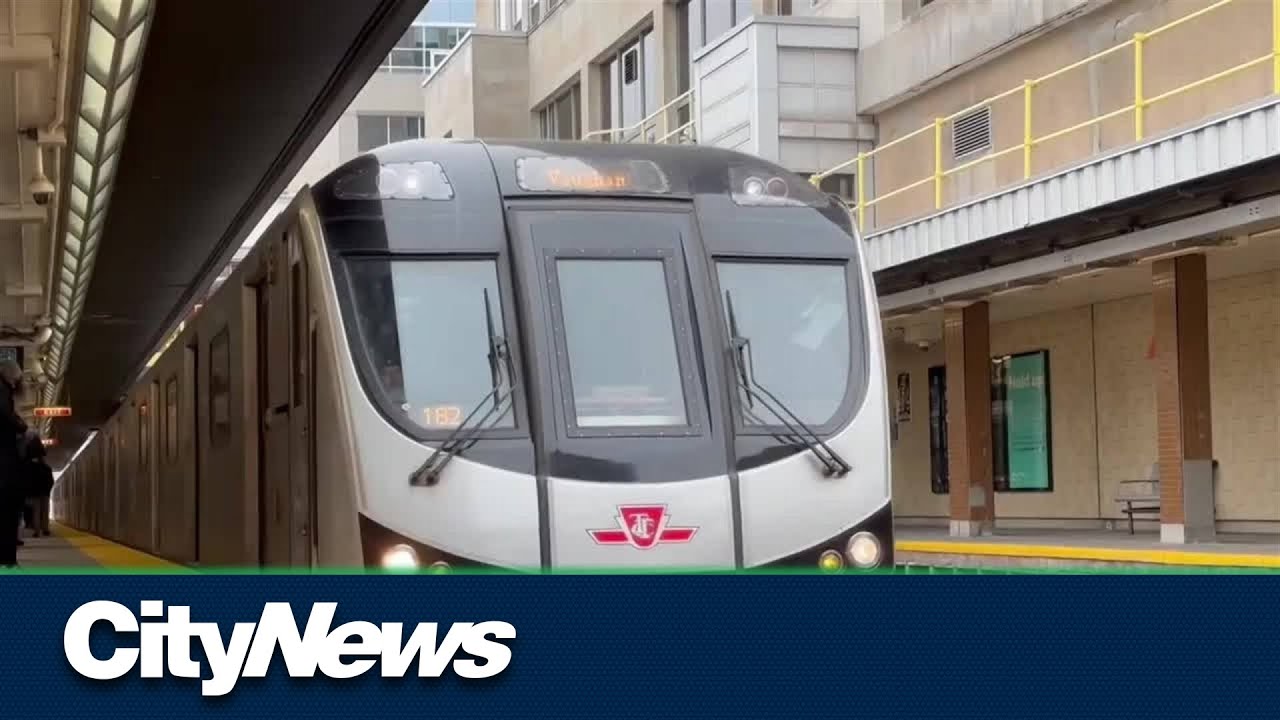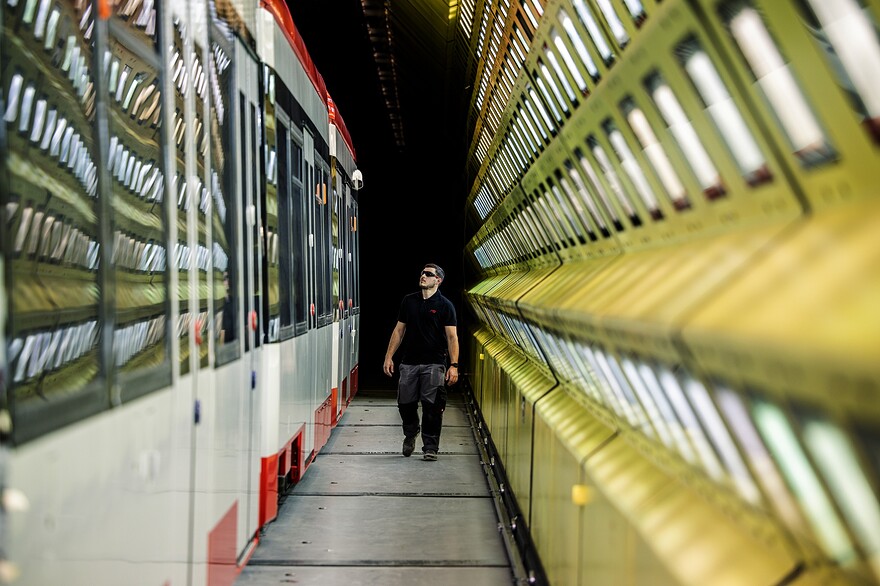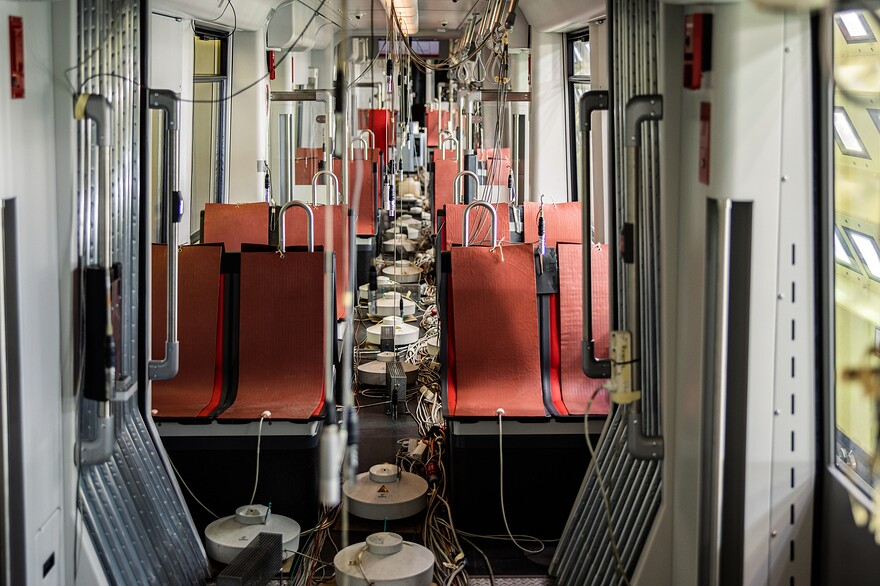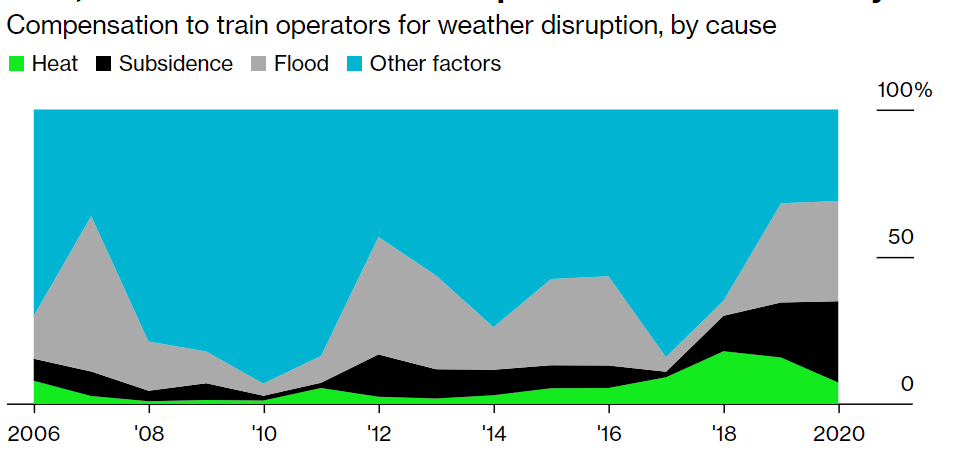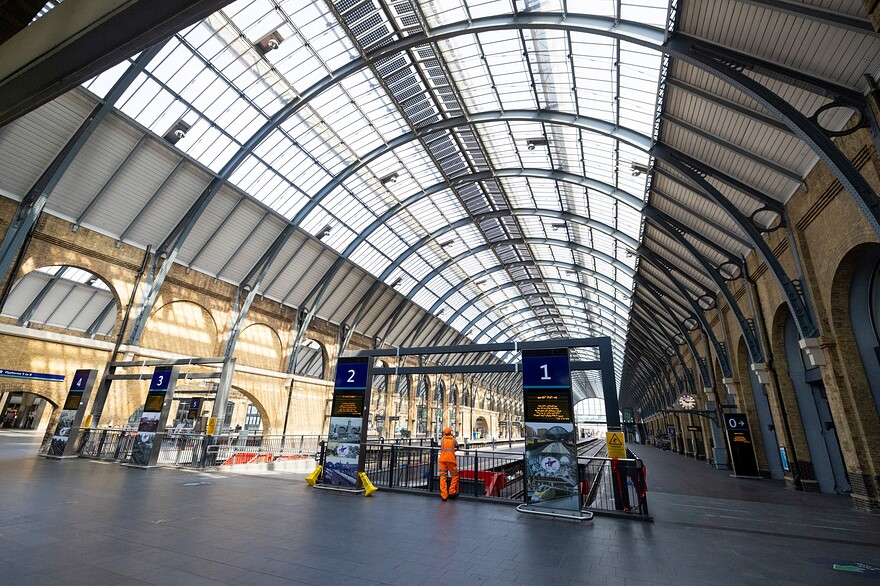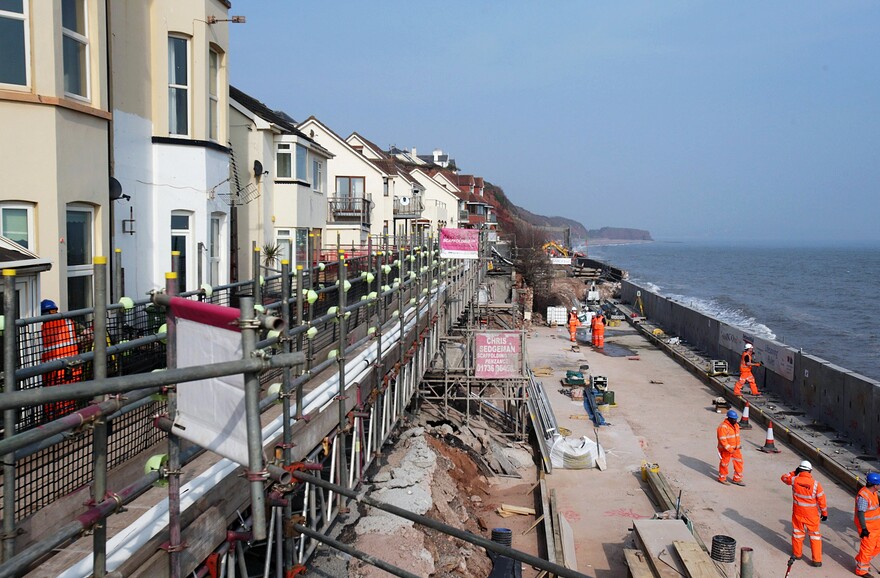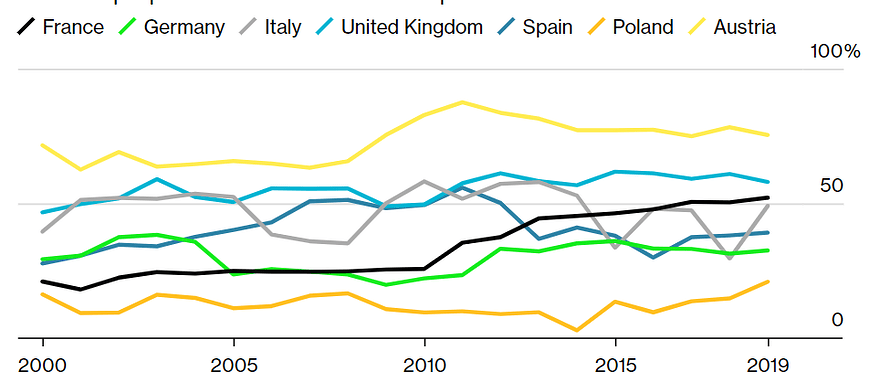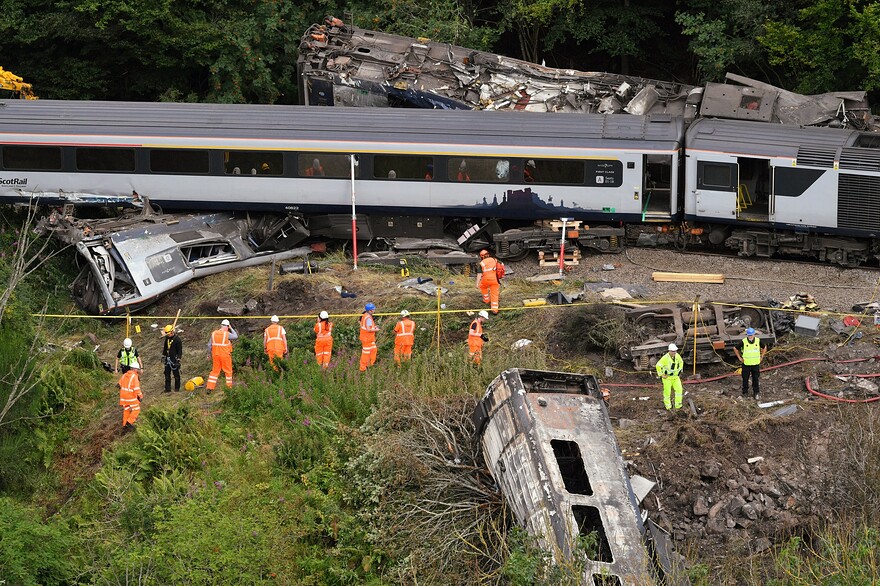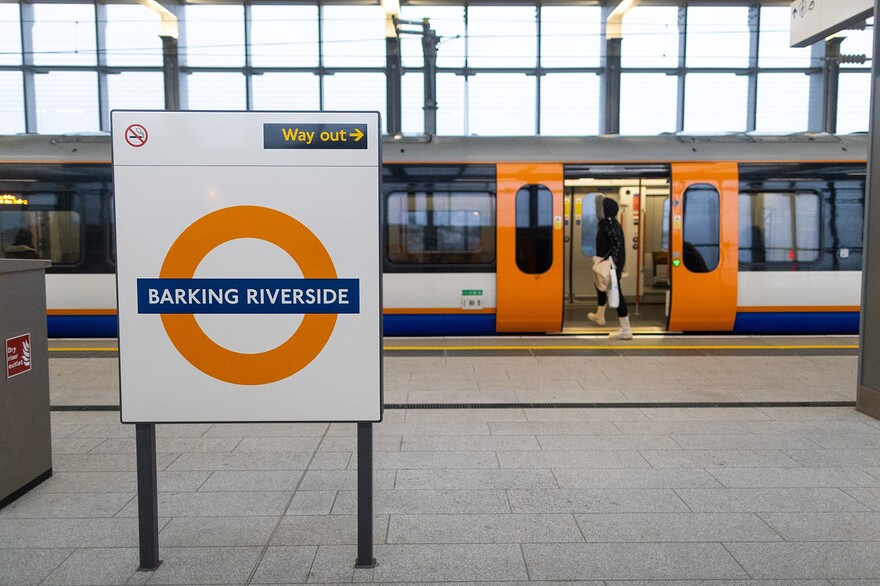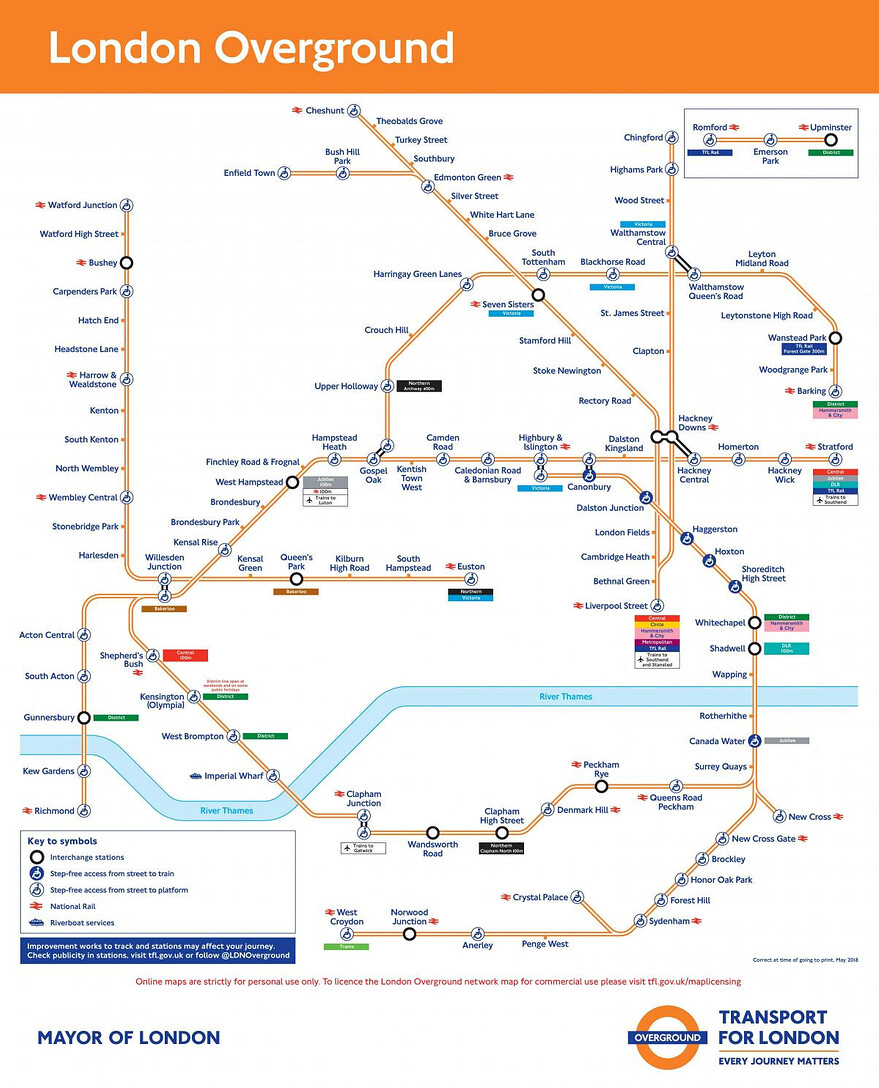Un long article de Bloomberg sur les répercussions des changements climatiques sur le transport ferroviaire en Europe
Texte complet : Climate Change Threatens Europe’s Trains, But Resilience Is Expensive
Climate Change Threatens Europe’s Trains, But Resilience Is Expensive
A sun simulation in the weather tunnel at the Rail Tec Arsenal facility in Vienna.
Photographer: Akos Stiller/Bloomberg
Increasing train travel is critical to decarbonizing transportation. As extreme heat, flooding and erosion pose risks to railways, investment in upgrades remains flat.
By Olivia Rudgard
February 15, 2024 at 1:00 a.m. EST
Green
The air is hot inside the packed tram. There are no passengers, though. Just dozens of heaters — standing in the aisles and on the seats — meant to simulate them. Instead of rushing through a city street, the tram is stationary inside a weather tunnel in Vienna, some 600 miles from Duisburg, the German city where it’s due to spend its working life—once it passes a climate assault course.
This weather tunnel at Rail Tec Arsenal, on the outskirts of Austria’s capital, is the world’s largest climatic wind tunnel. It tests 15 trains each year for train and tram companies around the world, along with planes and cars. It is painted neon green inside, for reasons that have nothing to do with its function, but the color adds to the intense otherworldliness of the space.
Rail Tec Arsenal promises “weather as bad as you need,” and they mean it: The tunnel can get as cold as -45C and as hot as 60C [-49F to 140F]. Today, though, the chamber is heated to 31C [87.8F] with simulated wind rushing by at 12km/hr [7.5mph], to approximate gliding through the streets of Duisburg on a hot summer afternoon.
Europe’s railways, a safe, low-carbon technology that still carry a little glamor, are on the brink of a new era. Governments are banning some short-haul flights and cities are investing in mass transit to discourage driving. But a hotter world brings threats to rail. Heat bends tracks and sags overhead cables; rain floods lines and collapses embankments; storms topple trees and erosion eats away at seaside cliffs, leaving coastal tracks dangling in mid-air.
Checking metering instruments during the sun simulation at the Rail Tec Arsenal facility in Vienna. The tunnel has also served as a set for a movie and a music video.Photographer: Akos Stiller/Bloomberg
Heaters inside the train.Photographer: Akos Stiller/Bloomberg
“A lot of national policy as well as European policy is to promote rail transport, which is pushing people towards taking more trains. But at the same time, there’s a lack of long-term adaptation,” says Tania Martha Thomas, a researcher at Climate Chance, a Paris-based NGO. “The pace of adaptation does not seem to be keeping up with the pace of observed changes in the climate.”
Duisburg’s old fleet dated back to the late 1980s and early 1990s, and did not have air conditioning, but this new one does, says Andreas Offer, head of rail vehicle technology at DVG, Duisburg’s transport operator. Offer and his colleagues are monitoring the AC during the test at Rail Tec Arsenal to make sure it’s not drawing too much power, while still keeping the train cool. A more efficient system uses less energy and is less likely to fail in hot weather—exposing passengers to an uncomfortable and even dangerous situation.
Railways have to adapt. The alternative is a doom-loop of driving, flying and ever-more extreme climate change, says Noel Dolphin, head of UK projects at Furrer + Frey, a railway electrification company. “There’s a risk that it becomes a self-fulfilling prophecy. Extremes in climate make the railway unreliable, which moves people to cars, which increase carbon, which makes everything more unreliable, because we get more and more extreme weather.”
One July day in 2022, as summer heat broke records in Europe, hundreds of passengers boarded a train in Paris run by the French operator Thalys. They were headed to Brussels, but made it only a few miles. The train broke down, the air conditioning failed, and more than 600 people sat in 45C conditions for more than four hours before being evacuated. Some passengers collapsed; others forced doors open or smashed windows for air. Thalys later said the failure was linked to the high temperatures.
The Thalys debacle wasn’t the only incident that summer that laid bare the railway’s vulnerability to heat. Metal lines and cables are much hotter when the sun is shining on them, says Dolphin. Heat so extreme you could fry an egg out there; it’s a common metaphor, but in this case it’s literally true. At 40C, sun rays on metal tracks can raise the temperature of that metal to 70C, (at which eggs start to cook), or even hotter. Rails buckle and cables droop, disrupting the flow of electricity or blocking the line ahead. Trains grind to a halt.
Heat, Flood and Subsidence Disruption Grows on UK Railways
Compensation to train operators for weather disruption, by cause
Source: Furrer + Frey
Other factors include snow, wind, lightning and cold
Heat, historically a relatively minor threat to European trains, is growing in importance. In the UK, operators get a payout from Network Rail, the infrastructure manager, to compensate them for lost income if services are disrupted or canceled by weather. In the past, most of these payouts have been linked to wind and flooding, but heat rose from 3% of claims between 2009 and 2014 to over 10% on average between 2015 and 2020.
One example is a section of railway from London to the west, towards Bristol and south Wales. The UK’s railways switched to diesel from steam over 50 years ago, and over the years some 38% of the total network has been converted again to run on electricity. Power comes from overhead lines or an electric “third rail,” which runs beneath the train. On this route, the first 12 miles leaving the UK capital were electrified in the 1990s, using equipment designed some 20 years earlier, under assumptions about the climate that are now wildly out of date. The rest was done around 2015, over 220 miles in total. Last year, Dolphin says, some 60% of all the failures were in that first 12 miles. (Network Rail declined to comment.) “It fails more, and more and more, and in every extreme weather event we have, it fails.”
London King’s Cross railway station after train cancellations due to a heat wave in July 2022.Photographer: Chris Ratcliffe/Bloomberg
Repairs on the Exeter to Plymouth railway line due to parts of it being washed away by the sea during storms at Dawlish, Devon, in March 2014.Photographer: Matt Cardy/Getty Images Europe
Dolphin suggests modifying the “set up temperature,” which is generally the median air range temperature at which the railway works as designed. Like any metal, rails and overhead electrification wires expand in the heat (which can make them buckle or sag) and shrink in the cold (which can make them stretch). Engineers can adjust the set up temperature by changing the position and length of the wires or rail depending on the outside temperature, a relatively small task that be done even on some old lines. Moving the set-up temperature can better manage the risks and help keep trains running.
Coastal erosion is another risk. A £165 million ($208 million) project in Devon in southwest England built a seawall and secured a cliff with netting and nails to protect a railway line which had been rebuilt after it was washed away by a storm in February 2014. Network Rail considered moving the whole line inland but decided keeping and protecting it presented better value. Moving inland might still be the fate of the Maresme rail line perched on the coast north of Barcelona. It would cost billions of euros, and the thrill of a journey where the passenger can pretend they are gliding over the sea would be lost. Yet the move would eliminate the threat of ever stronger waves and storms.
After a pandemic dip in the EU, more people are taking the train. Passengers traveled almost as many miles in 2022 as they did in 2019, and new long-distance sleeper routes are planned. Rail has an excellent safety record in Europe, but it also suffers from reputational damage each time an incident occurs. A derailment in Scotland in 2020 killed three people, including the train’s driver and conductor. A later investigation by the Rail Accident Investigation Branch, a government agency, found that a drainage system had not been properly installed prior to the derailment. When almost a month’s rainfall came down in three hours, debris was washed onto the track. Climate change, the report said, “will exacerbate this risk still further.”
Resilience costs money. Analysis by the International Transport Forum, a global intergovernmental organization, found that by 2021, only six of its 66 member countries spent more than half of their transport infrastructure budget on rail.
Rail Spending Has Stayed Flat in Major European Economies
Rail as a proportion of total inland transport infrastructure investment
Source: OECD
Includes both spending on new infrastructure and upgrades
The Scotland derailment was because drainage wasn’t being well monitored or maintained, says Dolphin. Observation is improving, though. Lidar and cameras mounted on trains are being used to scan every meter of the rail line, he says.
Repairs, though, can often lead to service disruptions and higher fares. “There’s a belief that the service is getting worse despite paying more. It’s almost like a perfect storm—the investment that is required at a time when there are unfortunately more service disruptions,” says Lorraine Blackwood, a former sustainability program manager at Network Rail, and an expert in nature-based solutions such as using plants and wetlands for drainage.
Emergency services inspect the scene following the derailment of the ScotRail train near Stonehaven, Scotland, on August 13, 2020.Photographer: WPA Pool/Getty Images Europe
And added cost can lead to closures. Britain’s High Speed Two rail project, which originally connected London to the northern cities of Leeds and Manchester, was an exemplar of climate resilience and durability but also one of the most expensive railways in the world, costing £396 million per mile. Last year the UK government canceled part of the route because of the cost.
No one is quite sure how much it will cost to make everything ready. **“**It’s probably a very big bill,” says Lucie Anderton, head of sustainability at UIC, an international industry group for railway operators and infrastructure managers. It’s even harder, though, to estimate the price of doing nothing.
“We need to invest just to keep it as good as it is today, and we know that the climate is going to get worse,” Anderton says. “You need to both invest more to adapt and invest more to expand.”
